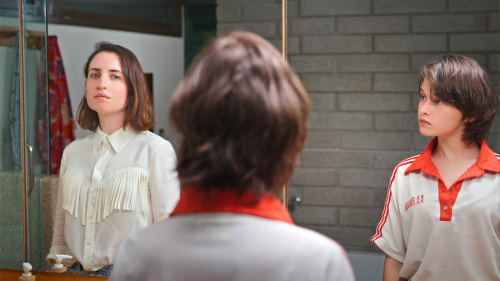
Daryl Wein/Sundance Institute
MOVIE REVIEW
How it Ends (2021)
In New York, when the world is about to end (in “Seeking a Friend for the End of the World”), people have restaurant orgies and riot and get arrested. In Canada, when the world is about to end (in “Last Night”), people count their orgasms and tip over trollies and have rooftop arguments at gunpoint. In Los Angeles, when the world is about to end in “How It Ends,” the mental picture you keep of your younger self becomes visible to all and helps you get ready for a party at Mandy’s house. Talk about cultural differences.
“How It Ends” really could only have been set in Los Angeles. Where else could an entire perfectly manicured city spend its final day baked out of its brains, enjoying wine and cake alone in their yards and chatting casually with passersby? But not Liza (Zoe Lister-Jones, who co-wrote and co-directed with her husband Daryl Wein). She and her younger self (Cailee Spaeny) have a lot of pancakes to eat and people to see: her mother (Helen Hunt), her father (Bradley Whitford, who is getting weirdly interesting as he ages), her most annoying ex (Lamorne Morris) and her former best friend (Olivia Wilde, unexpectedly funny). But her car has been stolen, so the Lizas must “hoof it” around the almost entirely deserted residential streets of Silver Lake, which involve casual encounters with people enjoying coffee (Fred Armisen), playing their guitar in the driveway (Sharon van Etten), buying up the entire dispensary (Nick Kroll), bickering over the recycling (Matt Besser and Paul Scheer) or tripping balls in the garden (Charlie Day and Mary Elizabeth Ellis). They also bump into Nate (Logan Marshall-Green), Liza’s most significant ex, who is also going to Mandy’s party.
It’s a day of sunshine, emotional conversations and imminent death, but does it add up to a hill of beans? Only when you realize that the peace Liza is trying to make is with herself. She has been kind of disappointed by things – her parents’ divorce, her break-up with Nate, her choice of acid-washed denim as the last thing she’ll ever wear – but she’s firmly determined to make the most of it, and so is everyone else. Communal weaponized wellness in the face of catastrophe will be analyzed in decades to come as the most potent drug of the current moment, and “How It Ends” portrayed it first. This is a movie that knows which has the bigger personal impact: that asteroid in the sky, or someone telling you something you’ve always longed to hear. The distracting string of encounters (which also include Ayo Edibiri, Finn Wolfhard, Glenn Howerton, Angelique Cabral, Whitney Cummings, Colin Hanks and one not to be spoiled) are all people who are, in one dumb way or another, also trying to be their best, most pain-free selves. There is a literal asteroid visible in the sky and people are going around talking about closure, and feeling heard, and “fear is just an obstacle that stands in the way of progress.” It’s ridiculous, but after the year we’ve all had, more than a little relatable. Ms. Spaeny has a basically impossible part and with awkward charm manages to convey teenage hopefulness before it’s curdled with disappointment. Their rapport is easy and unforced, and the choice to embody Liza’s feelings gives surprising heft to the inevitable end. And the way Ms. Lister-Jones sets her jaw as she confides it helps to have the party to look forward to can be seen in most mirrors, whether we want to admit it or not.
The movie was “made with love during the pandemic” and while no masks feature, social distancing does. Only in the final scenes does anyone get within touching distance of anyone else, and after the Lizas leave her house in the morning the rest of the film is entirely outdoors. It makes the ache for personal connection even more apparent, and a subtle reminder of everything we take for granted. As Lily Tomlin said, we’re all in this alone.
Comments